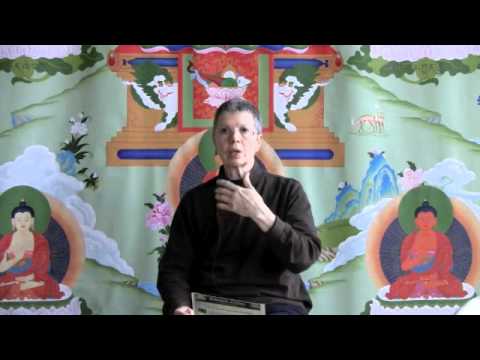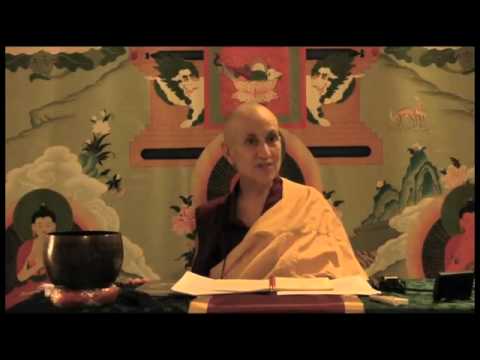Taking refuge from the heart
Part of a series of teachings given at the Winter Retreat from December 2011 to March 2012 at Sravasti Abbey.
- Reconnecting with refuge
- Taking the time to generate a motivation
- The three reasons to go for refuge
Vajrasattva 08: Taking refuge from the heart (download)
I have been invited to talk about taking refuge and generating the altruistic intention. I thought I would first talk about my experience doing the Vajrasattva retreat in 2003 (a long time ago). It was at the Kopan Monastery [in Nepal]. There was no Sravasti Abbey. Well, there was a Sravasti Abbey in someone’s mind but this physical place didn’t exist yet.
I went to Kopan and it was an incredible experience. At the beginning of the retreat, we were told to think of your retreat like a grain of rice. I thought, “That is very poetic, but I have planned this retreat for a year and a half, and this is really what is important: 111,111! [mantra recitations] A grain of rice? Sure!” But I had done the math. You see, I had really planned my whole life around this retreat and they did not understand that I had this certain number of malas I had to do per day. Their rice grain analogy was for the retreat: starting off gently and with grace; and then building momentum. But I was thinking, “No, I’m sorry, you don’t get it. I have got to do this because I have got purification to do! There are these huge things I have to get off my plate!”
Anyway, I’m sure that you’re not having this experience—but this was really driving my engine. And so, I went through all the things we had to go through in the sadhana. Of course Lama Zopa Rinpoche had designed the retreat and so there were other things we were doing in addition to the sadhana. There was Lama Chopa puja. I cannot remember all of it. There were just stacks of stuff. I would fly through that to get to my destination of doing the mantra. I got to be pretty fast. In fact, I was really fast. I had this wooden mala and I kept worrying that it would sort of light on fire. It didn’t.
The reason I mention that, is that I was flying through everything before that, including taking refuge and generating the altruistic intention. Sure, I was saying the words. Those are the words that we say at least five times a day on retreat. But there’s a huge danger in those just becoming rote—flying through them, and there is no heart connection at all. On the days where we can settle down I think we realize that, guess what? The momentum will build, you will get the speed you need, you will finish the retreat and you will have done probably more mantra than you even thought you could do.
That is not the issue.
And saying mantra really fast? I have never read in any text where there is some hero for saying mantra at lightning speed. We do not hear about those kinds of buddhas who can talk really fast. All of this occurred to me in about the last week of my retreat.
Heart advice
One thing I came across in one of the sadhanas that I am using right now is—say, if there’s a day where it’s just rote again, you are not feeling connected to taking refuge, try starting it with these words. Instead of saying, “I take refuge in the Three Jewels,” and all that—the usual one. Say, “From my heart, I go to the Three Jewels for refuge.” When I read that one it sort of stopped me in my tracks. So, “From my heart, I go for refuge.”
Then as Venerable Chodron reminds us, the whole reason for this part of the practice is that we are setting our motivation. That is really critical. This is going to set up what the rest of our session is going to be like. It’s going to set up the rest of our day. It’s going to set up the rest of our life because we are going to keep saying this refuge prayer. We can really take time there. Once we have figured out that, (anything else) is not so important, we can just relish it and cherish it.
Geshe Tegchok has some great advice on this part of this practice as well. He says:
The depth of our refuge corresponds to the strength of our motivation for seeking it.
He also says there are three reasons why we should go for refuge. The first reason is fear. I think all of us in the room have tasted some of that. This is why we’re here. I mean we could be anywhere else in the world right now. We could be on a cruise ship in the Caribbean. We are not. We are here at the Abbey doing retreat. We have fear of cyclic existence.
At the very least, if cyclic existence doesn’t scare the heck out of you, then take a look at aging. Go visit an old folks’ home. Go visit someone with Alzheimer’s or dementia. Go see what people are like in their eighth or ninth decade. That scares me. Some people are fortunate enough to have their minds intact, and some people, they don’t. This is not crazy, hysterical fear. It’s wisdom fear. That this is where we are headed, this body is not going to hold out, it’s going to come to an end.
The second reason for going for refuge is faith. He talks about three kinds of faith. The first one is called lucid faith. By lucid faith, he says just thinking of the Triple Gem and thinking of their qualities should make our mind happy. The second kind of faith he calls faith with conviction. This is why the room is filled right now. We have sampled the teachings, we know from parts of it that we can understand, it really works. We can transform our mind. The third reason for going for refuge is aspiring faith. He says this is the kind of faith that we have when we want to aspire for the qualities of the Three Jewels.
Next time I will talk about generating the altruistic intention. For now, I want to come back to the very first point. If it feels dry, if it feels rote, remember “From my heart, I go for refuge to the Three Jewels.”
Venerable Thubten Samten
Venerable Samten met Venerable Chodron in 1996 when the future Venerable Chonyi took the future Ven. Samten to a Dharma talk at Dharma Friendship Foundation. The talk on the kindness of others and the way it was presented is deeply etched in her mind. Four Cloud Mountain retreats with Ven. Chodron, eight months in India and Nepal studying the Dharma, one month of offering service at Sravasti Abbey, and a two month retreat at Sravasti Abbey in 2008, fueled the fire to ordain. This took place August 26, 2010 (see photos). This was followed by full ordination in Taiwan in March, 2012 (see photos), becoming Sravasti Abbey's sixth bhikshuni. Right after finishing a Bachelor of Music degree, Ven. Samten moved to Edmonton to pursue training as a corporeal mime artist. Five years later, a return to university to obtain Bachelor of Education degree opened the door to teaching for the Edmonton Public School board as a music teacher. Concurrently, Ven. Samten became a founding member and performer with Kita No Taiko, Alberta's first Japanese drum group. Ven. Samten is responsible for thanking donors who make offerings online; assisting Venerable Tarpa with developing and facilitating the SAFE online learning courses; assisting with the forest thinning project; tracking down knapweed; maintaining the Abbey database and answering email questions; and photographing the amazing moments that are constantly happening at the Abbey.


